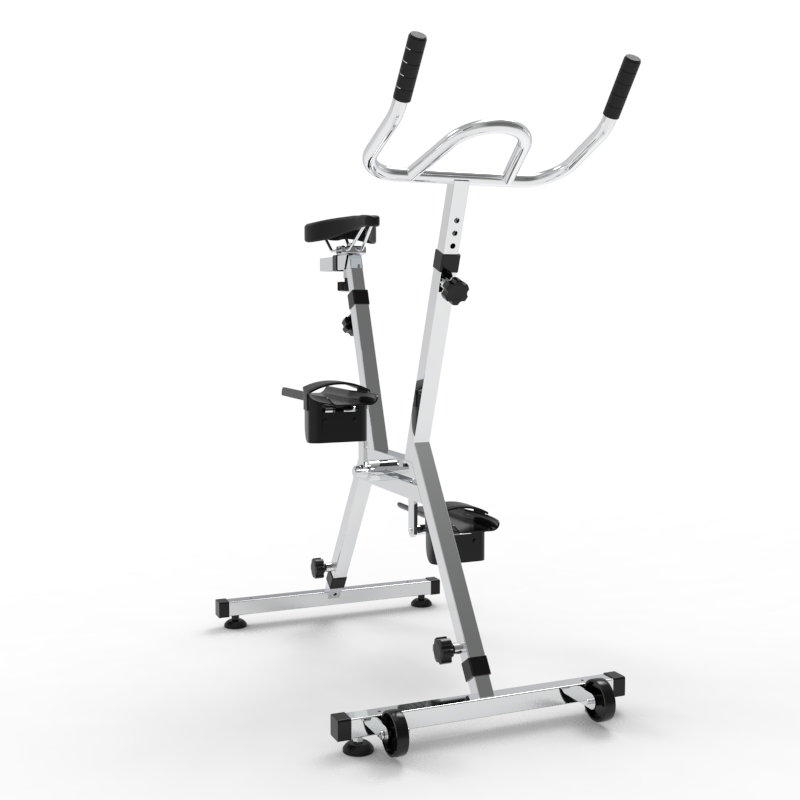Information about Under Water Bike
2023-10-16
An underwater bike, also known as an underwater exercise bike or aqua bike, is a fitness and rehabilitation device designed to be used underwater in swimming pools. It provides a low-impact cardiovascular workout and resistance training, making it suitable for individuals of various fitness levels and those seeking a gentle yet effective form of exercise. Here's some information about underwater bikes:
Design and Features:
1. Construction: Underwater bikes are typically made from corrosion-resistant materials like stainless steel or other metals that can withstand the pool's water environment.
2. Buoyancy and Stability: Aqua bikes are designed to be buoyant and stable in water. They often have features such as wide bases or stabilizing mechanisms to prevent tipping during use.
3. Adjustability: Many underwater bikes offer adjustable components, such as seat height, handlebar position, and resistance levels. This allows users to customize the bike to their comfort and fitness level.
4. Pedals and Resistance: Underwater bikes have pedals that users can pedal against the resistance of the water. The resistance can be adjusted to provide varying levels of challenge.
5. Handlebars: Handlebars provide support and stability while cycling underwater. Some models have stationary handlebars, while others might have movable or adjustable handles for different exercise positions.
6. Seat: The seat is designed for comfort during exercise sessions. It's usually ergonomic and contoured to accommodate various body shapes.
7. Drive Mechanism: The drive mechanism transfers the user's pedaling motion to the underwater bike's flywheel or resistance system, allowing for a smooth and consistent workout.
Benefits and Uses:
1. Low-Impact Exercise: Underwater biking is low-impact on joints, making it an ideal exercise for individuals with joint pain, injuries, or those seeking a gentle workout.
2. Cardiovascular Fitness: Aqua biking provides a cardiovascular workout that improves heart and lung health. The water's resistance adds intensity to the workout without putting excessive stress on joints.
3. Muscle Strengthening: Pedaling against the water's resistance helps strengthen leg muscles, including the quadriceps, hamstrings, and calf muscles.
4. Core Engagement: The water's buoyancy requires users to engage their core muscles for stability and balance, contributing to improved core strength.
5. Rehabilitation: Underwater bikes are commonly used in physical therapy and rehabilitation programs. The buoyancy of water reduces the impact on joints, making it suitable for individuals recovering from surgeries or injuries.
6. Weight Management: Aqua biking can aid in weight management by burning calories and improving overall fitness.
7. Flexibility: The water's resistance promotes gentle stretching and flexibility, enhancing range of motion and joint mobility.
8. Fun and Varied Workouts: Exercising in water can be enjoyable and refreshing, encouraging individuals to engage in regular physical activity.
9. Cooling Effect: Exercising in water helps regulate body temperature, preventing overheating during workouts.
Usage Considerations:
1. Pool Depth: Underwater bikes require a pool with sufficient depth to accommodate both the user's height and the bike's submerged components.
2. Water Temperature: While underwater exercise can be refreshing, maintaining a comfortable water temperature is important, especially for extended workout sessions.
3. Safety Precautions: Just like any exercise equipment, safety precautions should be followed. Proper use and supervision are important, especially for beginners.
Underwater bikes offer a unique and effective way to engage in fitness activities while enjoying the benefits of water resistance and buoyancy. Whether used for fitness, rehabilitation, or general well-being, underwater biking can provide a low-impact and enjoyable exercise experience.



